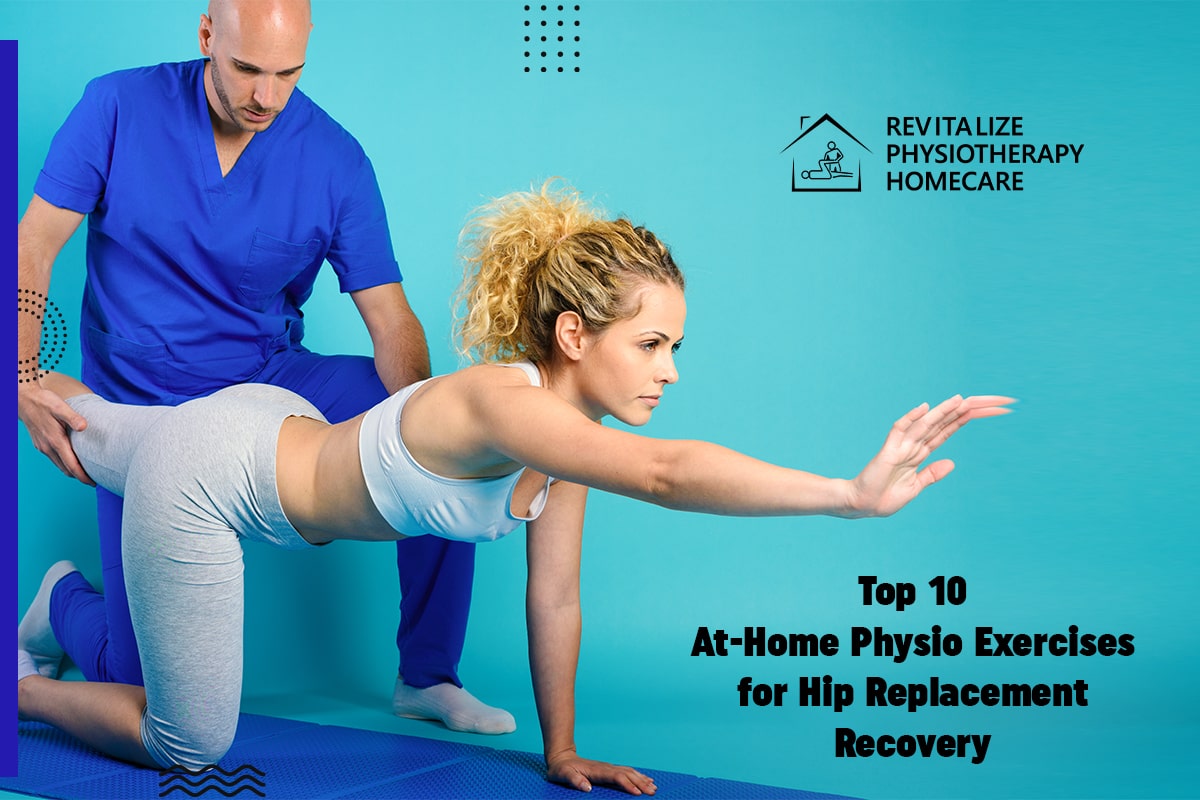Top 10 At-Home Physio Exercises for Hip Replacement Recovery
What is hip replacement?
Hip replacement surgery, commonly referred to as hip arthroplasty, is a technique that involves replacing a broken hip joint with a prosthetic implant. People with severe arthritis or hip fractures use this operation to alleviate pain and restore function.
Why is Hip Replacement Done?
Hip replacement is primarily performed for:
- Reduce chronic pain caused by osteoarthritis, rheumatoid arthritis, and osteonecrosis.
- Improve mobility and function which allows people to carry out their everyday tasks more easily.
- Improve the quality of life for those without relief from alternative treatments such as physical therapy or pharmaceuticals.
Importance of At-Home Physiotherapy
Post-surgical physiotherapy is essential for a full recovery. At-home physiotherapy activities aim to:
- Strengthen the muscles surrounding the hip joint.
- Increase flexibility and range of motion.
- Avoid issues like blood clots.
- Encourage a rapid return to routine activity.
10 At-Home Physio Exercises for Hip Replacement Recovery
Recovering from a hip replacement surgery can be challenging, but with the right physiotherapy exercises, you can regain strength, flexibility, and mobility from the comfort of your home. Here are the top 10 at-home physio exercises that can aid in your hip replacement recovery.
1. Ankle Pumps
Purpose
To increase blood flow and minimize swelling in the legs and feet.
How to Perform
- Sit or lie down, legs outstretched.
- Gently flex your foot up and down at the ankle joint.
- Repeat this activity 10-15 times, 2-3 times each day.
2. Quad Sets
Purpose
To strengthen the quadriceps muscles without moving the knee.
How to Perform
- Sit or lie down with your legs extended.
- Tighten the muscles on the top of your thigh by pressing the back of your knee downward.
- Hold the contraction for 5-10 seconds and then relax.
- Repeat 10-15 times, 2-3 times a day.
3. Gluteal Squeezes
Purpose
To strengthen the gluteal muscles, which support hip function.
How to Perform
- Lie on your back with your knees bent and feet flat on the floor.
- Squeeze your buttocks together as tightly as possible.
- Hold for 5-10 seconds, then relax.
- Perform 10-15 repetitions, 2-3 times daily.
4. Heel Slides
Purpose
To improve knee and hip mobility.
How to Perform
- Lie on your back with your legs extended.
- Slowly slide one heel up toward your buttocks, bending your knee.
- Slide your heel back down to the starting position.
- Repeat 10-15 times per leg, 2-3 times a day.
5. Short Arc Quads
Purpose
To strengthen the quadriceps muscles.
How to Perform
- Lie on your back with a rolled-up towel or foam roller under your knee.
- Straighten your knee by lifting your foot off the ground while keeping your thigh on the roll.
- Hold for 5-10 seconds, then lower your leg.
- Repeat 10-15 times, 2-3 times daily.
6. Hip Abductions
Purpose
To strengthen the hip muscles.
How to Perform
- Lie on your non-surgical side with your legs straight.
- Lift your top leg slowly toward the ceiling.
- Lower it back down with control.
- Perform 10-15 repetitions, 2-3 times a day.
7. Seated Marching
Purpose
To improve hip and knee mobility and strengthen the hip flexors.
How to Perform
- Sit on a chair with your feet flat on the floor.
- Lift one knee as high as comfortable while keeping your back straight.
- Lower your leg and repeat with the other knee.
- Perform 10-15 repetitions on each side, 2-3 times a day.
8. Standing Hip Flexion
Purpose
To strengthen the hip flexors.
How to Perform
- Stand behind a chair or countertop for support.
- Lift your knee toward your chest as high as comfortable.
- Lower your leg back down.
- Repeat 10-15 times per leg, 2-3 times daily.
9. Standing Hip Extensions
Purpose
To strengthen the hip extensors and improve balance.
How to Perform
- Stand behind a chair or countertop for support.
- Extend one leg backward without bending your knee.
- Hold for a moment, then return to the starting position.
- Repeat 10-15 times per leg, 2-3 times daily.
10. Mini Squats
Purpose
To strengthen the quadriceps, hamstrings, and gluteal muscles.
How to Perform
- Stand with your feet shoulder-width apart and hold onto a sturdy surface for balance.
- Lower your body into a mini squat, keeping your back straight and knees behind your toes.
- Return to the standing position.
- Perform 10-15 repetitions, 2-3 times a day.
Tips for Safe Exercise
- Warm-Up: Always start with a gentle warm-up to prepare your muscles and joints.
- Pace Yourself: Gradually increase the intensity and duration of your exercises as your strength improves.
- Listen to Your Body: If you experience pain, stop the exercise and consult your physiotherapist.
- Stay Consistent: Regular exercise is key to a successful recovery.
Conclusion
Incorporating these Hip Replacement Physio at-home exercises into your everyday routine can greatly help with hip replacement rehabilitation. Always contact your doctor or physiotherapist before beginning any new workout program to confirm that it is safe and appropriate for your condition. With dedication and consistency, you can have a smoother and faster recovery, restoring your mobility and quality of life.
Are you ready to take your recovery to the next level? Revitalize Physiotherapy and Homecare specializes in specialized at-home physiotherapy programs tailored to your specific needs. Our skilled physiotherapists are dedicated to assisting you in achieving optimal recovery while providing convenience and care right at your home.
Contact us today to set up your first session and see the difference expert home physiotherapy can make! Reach out to us at revitalize@physiocare.com or call us at 905-452-0222.




